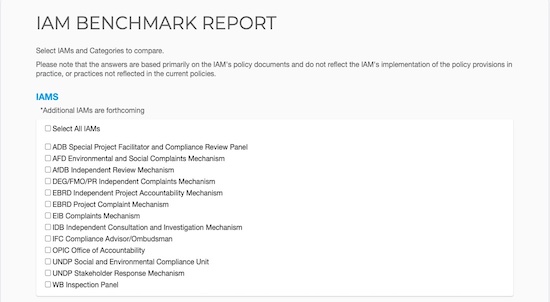How to Compare IAM Policies with the Benchmark Reports Feature

Understanding how policies and operating procedures vary at different IAMs is a critical component of accessing the mechanisms for communities, and of informing advocacy for best practices at IAMs. The IAM Benchmark Report feature allows users to view and compare policies across mechanisms, and provides insights into how particular policies influence complaint outcomes.
For community members in Ukraine, living amongst the largest poultry farm in Europe has had resounding negative impacts on their livelihoods, property, health, and safety. The poultry company Myronivsky Hliboproduct (MHP) operates all stages of the poultry production and controls 370,000 hectares of cropland in Ukraine. Together, the International Finance Corporation (IFC) and the European Bank for Reconstruction and Development (EBRD) have provided more than US$600 million in financing to MHP. In June of 2018, community members represented by local civil society organizations filed a complaint, documenting the harm resulting from MHP’s operations and seeking potential resolutions through a mediated dialogue. Complainants decided to jointly file their complaint to both the CAO and PCM, the respective accountability offices of the IFC and EBRD. When multiple development finance institutions are involved in funding the same project, complainants may wish to raise their grievances at each accountability office. The process of jointly filing complaints to more than one mechanism can help increase the likelihood that complainants will have their concerns heard and addressed, though it does not come without its own challenges. The requirements and procedures at each IAM can vary quite widely, and navigating these requirements successfully is essential to accessing redress through an IAM.

The “largest poultry farm in Europe” expanded throughout the region over the past 10 years
How Differences in IAM Requirements Can Impact Complaints
Even at the earliest stage of complaint filing, differences in IAM requirements occur. For example, while some mechanisms like the CAO allow complaints to be submitted in any language, others like the PCM have restrictions on the languages complaints may be filed in. Specifically, the PCM operating procedures (as do the updated IPAM procedures) state that complaints may be submitted in any of the working languages of the Bank (German, French, Russian), or in any of the official languages of the Bank’s countries of operation. Language requirements such as these can preclude communities from having their complaints accepted, which is especially critical in considering that many affected communities are minorities, and may not speak or be literate in a country’s official language. From our own involvement in client case work and community support, it is evident that staying apprised of IAM requirements and procedures is crucial to successfully navigating through an IAM complaint process. In order to do this effectively, we’ve analyzed over 200 policy benchmarks related to IAM operating procedures (171 are currently publicly available, with 44 additional benchmarks forthcoming). We’ve incorporated these benchmarked policies into the Console, which comprise the IAM Benchmark Report feature.
Creating a Benchmark Report
The IAM Benchmark Report feature allows users to view and compare policies across mechanisms using a simple form. Users can select any combination of IAMs, and any number of policy benchmarks. For ease of use, we’ve grouped policies into broad categories. Users can opt to select an entire category of policy provisions, which is helpful in situations where users are interested in understanding how eligibility requirements vary by mechanism, or how the requirements around filing or delivering a complaint vary by mechanism. To look at particular questions within categories, users may view and select individual questions by clicking on a given category, as shown below. Once users have selected the IAMs and questions they’re interested in comparing, they can click the View button, which will load their custom benchmark report.

Choosing categories and questions
Viewing the Report
Each benchmark report is organized in a table with columns for the question category, question, and each IAM. The values recorded for each IAM are generally simple Yes, No, or Unknown/Other answers to each of the questions. Clicking on any of the values will bring up a detailed page on that exact policy question at that mechanism, including the date that policy went into effect, any important notes we’ve identified, a link to the exact policy citation from the mechanism, and the date that the information presented was last updated by our team.

The benchmark report links out to detailed answers to each question
Individual Benchmarks
The individual policy benchmark page also includes a table of how other IAMs compare on the same policy benchmark. Below the table, we’ve included charts showing how complaint outcomes differ based on this policy. The charts are insightful to see how mechanisms with and without this policy may broadly influence complaint outcomes and particular complaint stages, however conclusions from these charts alone are highly limited, as many additional factors of the complaint process, mechanism differences, and other outstanding variables are not accounted for.
Understanding how policies and operating procedures vary at different IAMs is a critical component of accessing the mechanisms for communities, and of informing advocacy of best practices for IAMs. For communities and their advocates navigating IAMs, understanding policy requirements and procedures is essential to all stages of the complaint process. Understanding what particular policy requirements translate to for communities is critical to ensuring effective, fair, transparent, and accessible accountability mechanisms.
This article was originally published in the Accountability Console Newsletter, where AC’s Research team shares research and insights from the world’s most comprehensive database of Independent Accountability Mechanism (IAM) complaints, the Accountability Console. Click here if you would like to subscribe to the monthly Console Newsletter.

